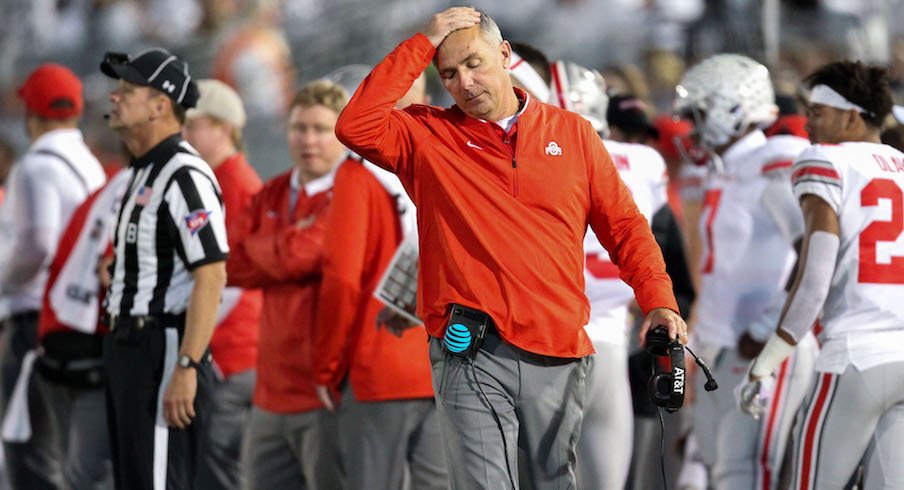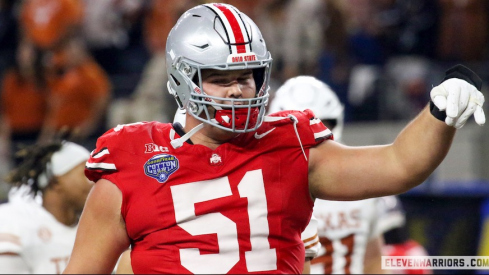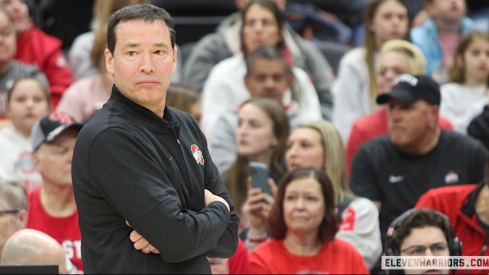Millions watched on television and more than 100,000 people were in Ohio Stadium when Urban Meyer fell to one knee in the fourth quarter of his team’s 49-26 win against Indiana on Oct. 6.
The seventh-year Ohio State coach had nowhere to hide.
Meyer went to the ground holding his head because he was dealing with what would eventually end his run as Ohio State’s head coach: a severe headache caused by an arachnoid cyst in his brain.
Athletic director Gene Smith was in the stadium, saw the incident and was concerned enough that he now says he was ready to pull Meyer off the sideline and out of the game in the future if the headaches flared up and caused him to fall to the ground again.
“You're evaluated every Saturday for four hours in front of 106,000 people, and our viewership is always six million or higher across the platforms, and he went down on one knee,” Smith said Thursday morning. “That's medical. That's bad. To the point, the following week, I had a meeting with about six people around him saying we've got to have a management strategy because if you go down again, I've got to take you out.”
On Oct. 12, the Friday before Ohio State’s game against Minnesota, Smith held a six-person meeting that included director of football sports performance Mickey Marotti, director of player development Ryan Stamper, general manager Brian Voltolini, executive associate athletics director Diana Sabau and Meyer.
During the meeting, Smith helped to design out a plan that curtailed Meyer’s headaches and minimized their effects during games. After speaking to doctors, Smith realized Meyer needed to keep his headset on as much as possible.
“Because it keeps the noise out,” Smith said. “The noise is a stimulant for the headache. So, I had the doctors there. What's the stimuli that causes headaches? The intensity.”
Smith said they kept a close eye on his intensity. Voltolini, who is in his 18th season working with Meyer and will be retained as general manager on soon-to-be head coach Ryan Day’s staff, was tasked with hitting him on the hip whenever his intensity rose too much.
“When he started to scream, Volt would hit him,” Smith said. “Most people didn't even notice that. You go look at it. You can find it. There's times when Volt” – Smith made a motion of Voltolini slapping Meyer on the side of his hip – “and walk away.”
Meyer never fell to a knee again the remainder of the season, but he ultimately decided to end his tenure as Ohio State’s head coach largely due to the headaches that have worsened since he had surgery to drain the cyst in the spring of 2014.
“That's what people are missing is the health was a big part of it. So, whether he comes back and coach, I think it depends on that. Because he's not stupid, now. He knows that that could take him out.”– Gene Smith
The headaches “hit real hard” during last year’s 39-38 win against Penn State and did not improve this season.
“The decision was a result of cumulative events,” Meyer said during Tuesday’s press conference. “And health number one. The fact that we have an elite coach on our staff, the fact that our program is very healthy, we've recruited very well, all played a significant role in this. And I can't say ‘This is the reason, this is the reason.’ But there's cumulative reasons that we're at this point.”
When asked whether he would ever return to coaching, Meyer said, “I believe I will not coach again.” A reporter followed up and asked whether he was fairly certain he was finished, and he responded, “I’m certain, yes.”
Smith said when Meyer told him on Sunday he had decided to retire, he believed him when he said he was completely done coaching.
“That's what people are missing is the health was a big part of it,” Smith said. “So, whether he comes back and coach, I think it depends on that. Because he's not stupid, now. He knows that that could take him out.”
With most of the focus on how Meyer acted with endless intensity on the sideline in the past month, Smith felt like many people didn’t realize or consider how the headaches affected his health and well-being.
“The thing that I try to tell people, and I've said it, I can't imagine what your life is like when you have a cyst in your brain that's not operable,” Smith said. “They can't go in and take it out. I don't know what that means. I can't relate to that. I don't put my head on a pillow at night and think about that or go through like an hour or 90 minutes of headaches as a result of that, and then it subsides and you're going through your day making sure you don't do something to bring those – I can't relate, and that's what we watched.
“And that's what people are, I think, sometimes missing it. We all watched it. Talked about his behavior on the sideline. But nobody like really said, 'Jesus Christ, what is that like?'”


